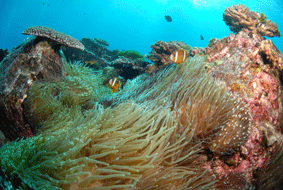Not only that, the density of anemones there are increasing! The survey found that populations of some of the most common species had increased by more than 500 percent from the last surveys completed in 1994 and 1995.
Anemones find the ideal home
Southern Cross University 7 Jul 09;
The waters of the Solitary Islands Marine Park off Coffs Harbour are home to the world’s highest density of host sea anemones and the population, according to a recent survey, is increasing.
Dr Anna Scott, from Southern Cross University, in conjunction with the NSW Marine Parks Authority, has completed a survey of the host sea anemones and their anemonefish, in the waters around North Solitary Island.
The survey found that populations of some of the most common species had increased by more than 500 percent from the last surveys completed in 1994 and 1995.
“Not in my wildest dreams did I think there would be such an increase in these populations,” said Dr Scott, who is based at the National Marine Science Centre. “What we have seen is a really big increase in what was already a very unique population.”
The survey looked at the three species of anemone fish - barrier reef anemonefish, wide-band anemonefish and red and black anemonefish - and the bubble-tipped and leathery-tipped host sea anemones, found in the Solitary Island
Marine Park (SIMP).
“There was a 133 percent increase in the barrier reef anemonefish - the most common fish, and for the most common host sea anemone – the bubble-tipped anemone – the increase in density was over 500 percent at some sites,” Dr Scott said.
“We are very lucky at North Solitary Island because it is located in a sanctuary zone – which is a ‘no-take’ zone. That lessens the human impact.”
Another reason for the dramatic increase in the population was the ability of one of the anemones to asexually reproduce.
“The most abundant species of host sea anemone can literally just split itself in two,” she said.
“It splits by pulling itself in two directions and ends up with all the internal tissues exposed. Then it goes through the process of repairing itself. The other species of anemone, which only reproduces sexually, is not as abundant and numbers have remained similar to those previously reported.”
While there are more than 1000 types of sea anemone in the world, only 10 are known to provide a home for anemonefish such as the popular ‘Nemo’ character from the film ‘Finding Nemo’, making them highly prized for the aquarium trade.
“The substantial increases in anemone and anemonefish numbers found during this study contrasts with what is happening in many other areas of the Indo-Pacific,” Dr Scott said.
“The collection of these animals for the marine aquarium trade is causing reductions in abundance. This causes problems for both the anemones and their resident fish. If too many anemones are removed the fish cannot survive in the wild without their homes.
“Conversely, if too many fish are removed it can leave the anemones vulnerable to predation. Anemonefish function like guard dogs for their anemone homes, they do their best to aggressively ward off any potential predators that come along.”
Dr Scott said climate-related phenomena might cause the anemones to bleach, just like their coral relatives.
“If bleaching is severe the anemones can die as a result,” she said. “This highlights the need for more studies like this. We need this information so that we can try to ensure the conservation of these iconic species.
“We need to make sure we keep ‘Nemo’ safe and sound.”
Media contact: Brigid Veale, Southern Cross University communications manager, 02 66593006 or 0439 680 748.

